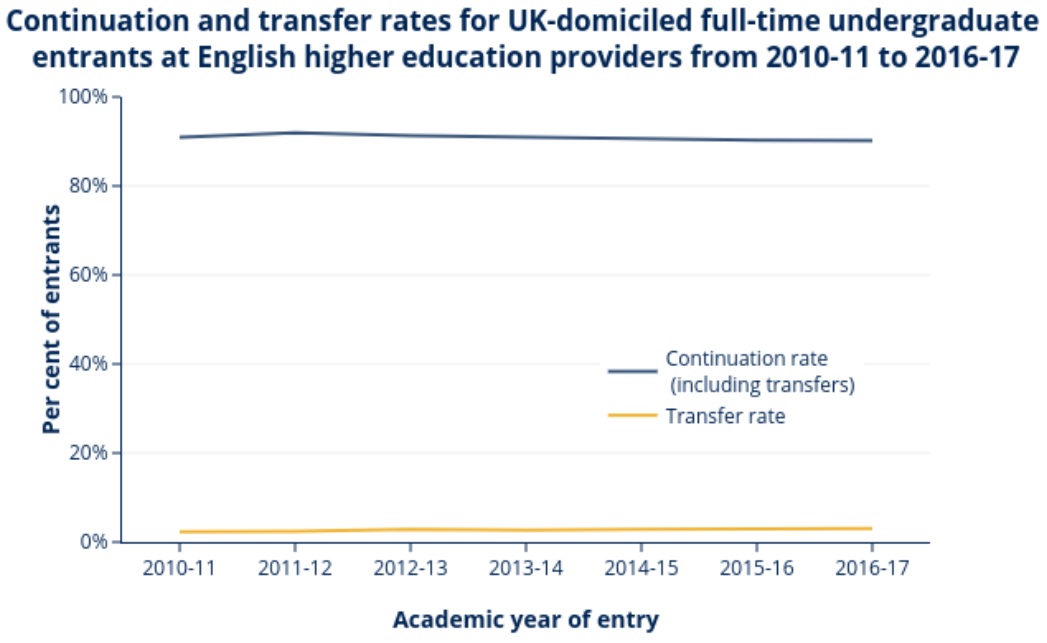Continuation and transfer rates
These pages look at the study activity of full-time undergraduate students one year and 14 days after the start of their studies. Study activities are grouped into one of the following:
- continuing with or have completed their studies
- have transferred to a different higher education provider to continue their studies
- are no longer in higher education and have not completed a qualification.
General trends
Continuation rates remain very high, although they have continued to drop very slowly in a trend that started in 2011-12.
Of all students who began their studies in 2016-17, 90.2 per cent continued studying, transferred to another provider or had qualified one year and 14 days after starting their studies. This is almost unchanged compared with the previous year.
The number of students transferring to a different higher education provider has increased. This continues the small upward trend that began in 2013-14.
In the academic year 2016-17, 3.1 per cent of students transferred to a different higher education provider, a slight increase from 3.0 per cent in the previous year.

Findings
All the percentages presented in this section relate to the academic year 2016-17.
Age at entry
- Continuation is much higher for young students than for mature students (92.2 per cent and 84.8 respectively). The continuation rate of mature students is significantly lower than the benchmark.
Disability
- Only 86.8 per cent of students who have reported having a mental health condition continued their studies, compared with 90.3 per cent of students with no reported disability.
- The continuation rate for students with a mental health condition was significantly lower (3.3 percentage points) than the benchmark.
- Transfer rates are consistently higher for students with a reported mental health condition (3.8 per cent) when compared with other types of disability (2.5-3.4 percent) and those with no reported disability (3.1 per cent).
- Students who have reported as having a cognitive or learning difficultly have a higher continuation rate than students with no reported disability (91.4 per cent compared to 90.3 per cent). Continuation for these students is significantly higher than the benchmark.
Disadvantage
- Students from the highest participation areas (based on POLAR4) and the least deprived areas (based on IMD) have the highest continuation rates.
- Those from the lowest participation and most deprived areas have the lowest continuation.
Ethnicity
- Transfer rates are lowest for white students (2.5 per cent) and highest for black students (4.8 per cent) and other ethnicity students (5.2 per cent).
- The observed transfer rates of all ethnic groups other than white are significantly higher than the benchmark.
Sex
- Female students consistently have higher continuation rates than male students, at all levels of study.
Provider group
- Continuation rates are lower at further education colleges and other higher education providers (79.8 per cent) than higher education institutions (87.7-95.8 percent).
Benchmarking
We know that some factors result in different continuation rates (for example, qualifications on entry and subject studied). We also know that these factors vary for different student and course characteristics.
For this reason, we have also published differences from a benchmarked rate. Without benchmarking, any differences between groups of students may simply be the result of differences in these other factors.
Contact us
If you have any questions or feedback on these pages, please contact William Rimington at [email protected] or the Foresight and Insight team at [email protected]
Describe your experience of using this website
